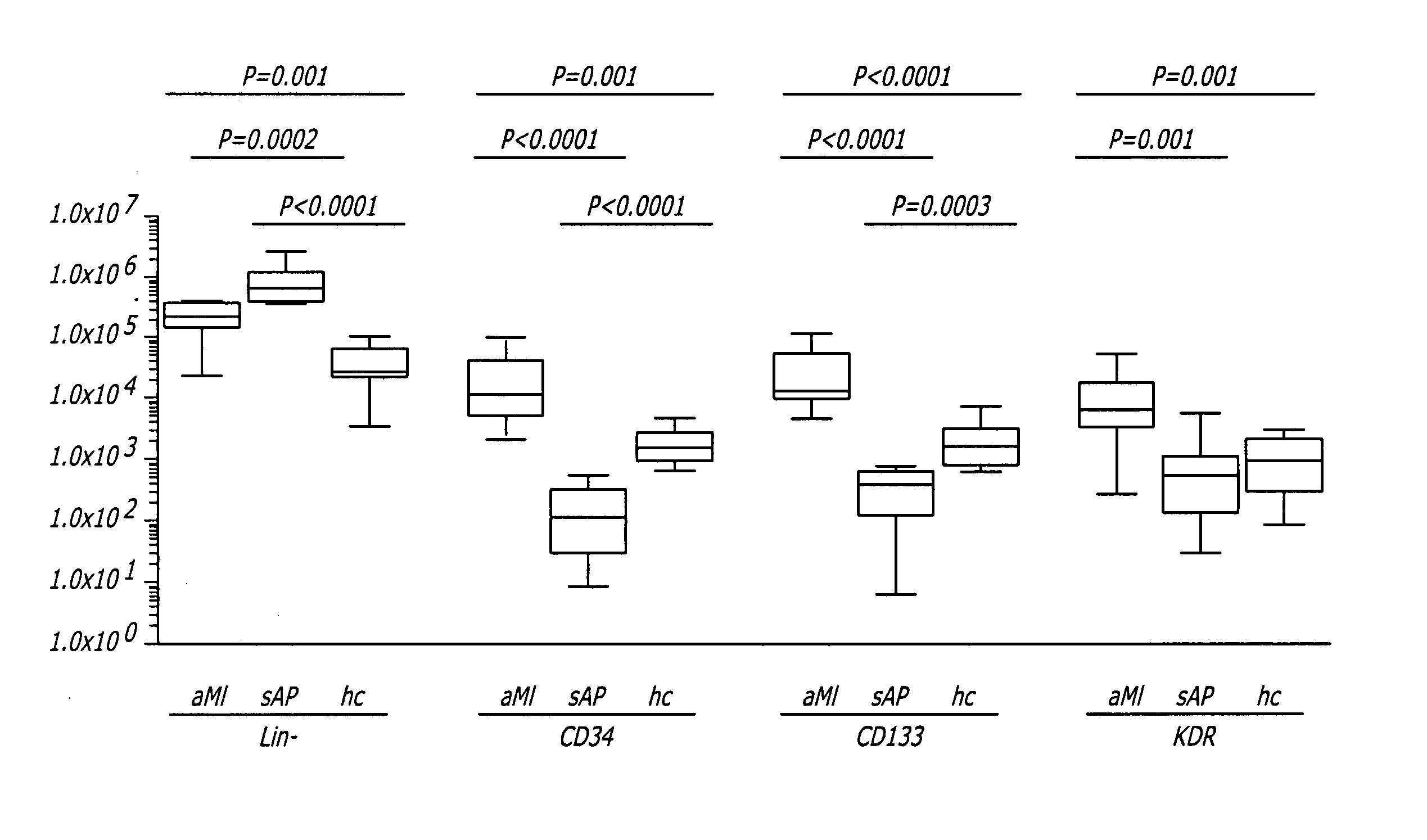Isolation of endothelial progenitor cell subsets and methods for their use
- Summary
- Abstract
- Description
- Claims
- Application Information
AI Technical Summary
Problems solved by technology
Method used
Image
Examples
example 1
Identification of Seven CPC Subsets by Four-Parameter Flow Cytometry
[0066] The phenotypic heterogeneity of endothelial progenitor cells (EPC) based on patterns of combined expression of three circulating progenitor cells (CPC) markers, CD34, CD133 and KDR was analyzed using four-parameter (three-color) flow cytometric analysis.
[0067] Mononuclear cells were isolated from heparinized blood by lymphoprep density gradient centrifugation (Nycomed, Oslo, Norway). Because the number of circulating progenitor cells (PC), irrespective of phenotype, is low, lineage-negative (Lin−) cells, i.e. uncommitted, potential PCs, were enriched from total peripheral blood mononuclear cells (MNC) by high-speed flow cytometry sorting, whereas Lin+ cells were discarded (FIG. 6A). Total MNC were stained with a cocktail of phycoerythrin (PE)-labeled monoclonal antibodies (moAbs) against CD3 (T cells), CD14 (monocytes), CD19 (B cells), CD16 / 56 (NK cells) and CD31 (mature endothelial cells) (all from IQ Corp...
example 2
CPC Numbers in aMI Patients and Healthy Controls
[0073] Ten aMI patients and nine healthy control volunteers were compared with regard to EPC numbers to determine whether the number of cells in the seven CPC subsets correlated with the event of aMI. A possible correlation between CPC numbers and aMI is reflected in the number of Lin− cells (within which CPC were detected). Numbers of Lin− cells were compared between the two subject groups. In aMI patients the number of Lin− cells averaged 2.6×105 cells / mL blood (range 0.2-4.7×105 cells / mL blood), which was significantly higher (P=0.001) than in healthy controls (mean 0.5×105 cells / mL blood, range 0.04-1.4×105 cells / mL blood) (FIG. 7), equivalent with a 5.2-fold higher number of Lin− cells in aMI patients as compared to controls.
[0074] The numbers of CPC expressing CD34, CD133 or KDR were compared in aMI patients and healthy controls. CPC numbers in all three subsets were significantly higher in aMI patients than in healthy controls...
example 3
Blood Vessel-Forming Activity of CPC Subsets
[0078] This experiment investigated the behavior of CPC subsets in vivo, primarily with respect to differentiation into mature endothelial cells (EC). CPC expressing either CD34, CD133 or KDR were sorted in 200 μL Matrigel® and supplemented with 10 ng basic fibroblast growth factor (b-FGF, Chemicon, Temecula, Calif.) and 12 U heparin (Leo Pharma, Ballerup, Denmark) at 5,000 to 15,000 cells per implant and implanted subcutaneously in nude mice. Bare Matrigel® contains the b-FGF and heparin supplement. After 14 days, the Matrigel® pellets were explanted, partly snap-frozen in liquid nitrogen for immunohistochemistry, or fixed in 2% paraformaldehyde in 0.1 M sodium phosphate buffer, dehydrated and embedded in resin (Technovit 8100, Heraeus Kulzer, Wehrheim, Germany). For overall morphologic evaluation, 2 μm sections of resin-embedded Matrigel® pellets were stained with toluidin blue. Morphologic analysis of the implants showed that by 14 day...
PUM
 Login to View More
Login to View More Abstract
Description
Claims
Application Information
 Login to View More
Login to View More - R&D
- Intellectual Property
- Life Sciences
- Materials
- Tech Scout
- Unparalleled Data Quality
- Higher Quality Content
- 60% Fewer Hallucinations
Browse by: Latest US Patents, China's latest patents, Technical Efficacy Thesaurus, Application Domain, Technology Topic, Popular Technical Reports.
© 2025 PatSnap. All rights reserved.Legal|Privacy policy|Modern Slavery Act Transparency Statement|Sitemap|About US| Contact US: help@patsnap.com



